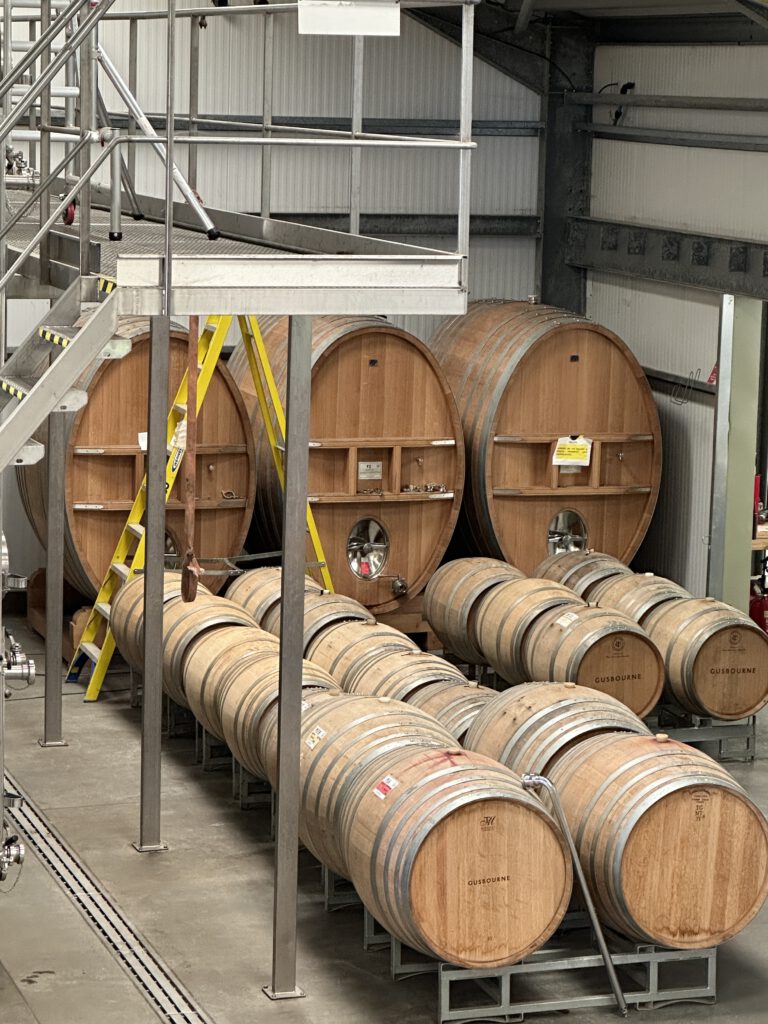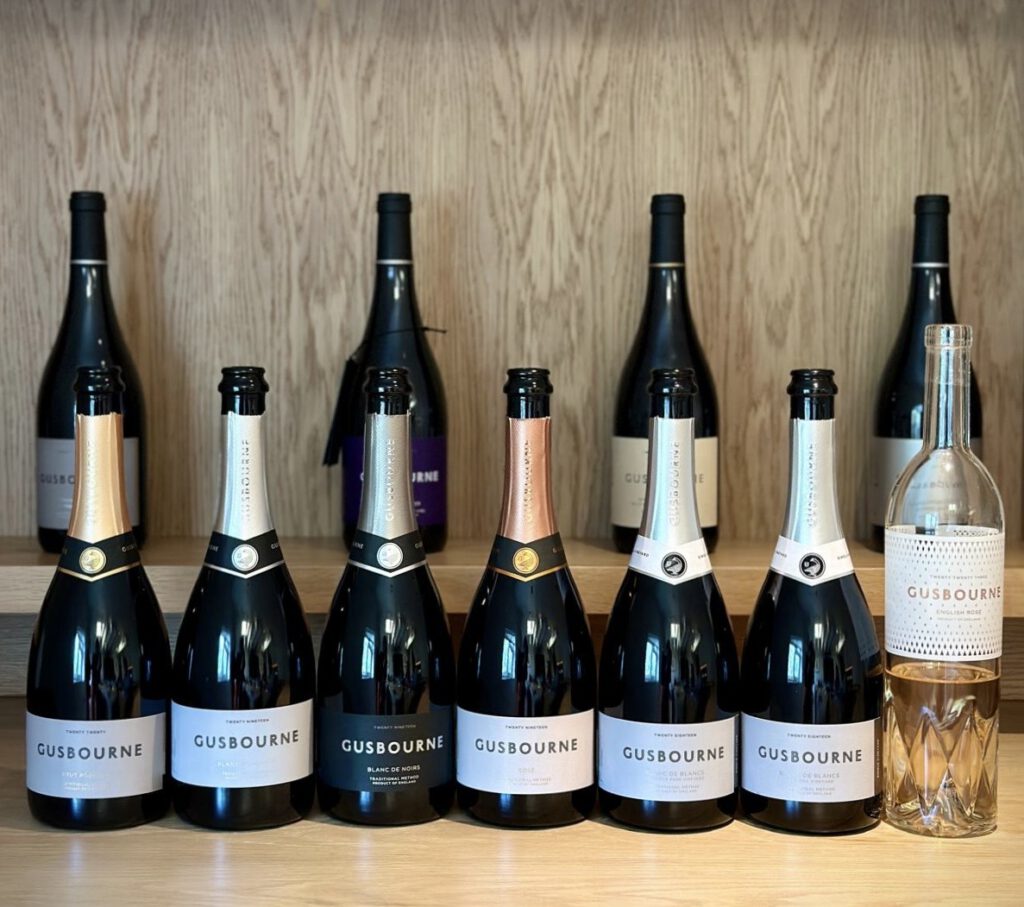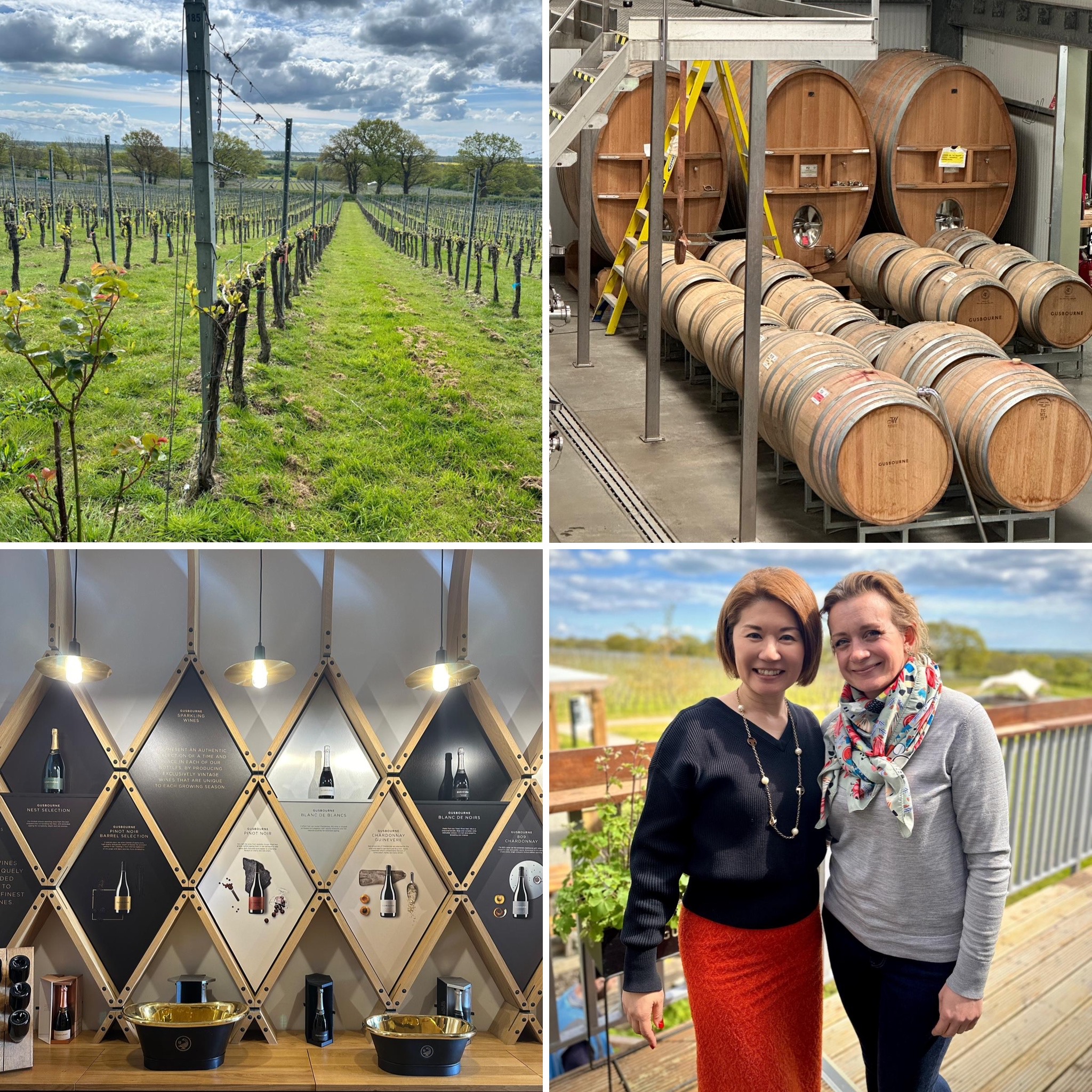Effervescence of Excellence: Gusbourne’s Path to Prestige.
English sparkling wines have emerged as strong contenders against premium-quality Champagne, gaining popularity in the global market over the past decades. Gusbourne, a prominent producer, is celebrating its 20th anniversary this year.
We have previously reviewed their sparkling and still wines, and attended a professional tasting event in Amsterdam, where we were impressed by their quality. In the past April, we finally had the delightful opportunity to visit Gusbourne’s winery in Kent, England. There, we delved into Gusbourne’s rich history, achievements, and promising future, guided by the insights of Jon Pollard, the COO and Chief Vineyard Manager, and Laura Rhys, the esteemed Head of Wine, Communications, Education.
Gusbourne: Visionary Pursuits
Gusbourne’s journey began in 2004 with a visionary founder, Andrew Weeber, at the helm. Their clear philosophy is cultivating the highest quality Chardonnay, Pinot Noir, and Pinot Meunier grapes across the Gusbourne Estate. With 60 hectares in Appledore, Kent, and 30 hectares near the Goodwood Estate in West Sussex, the estate’s vineyards are a testament to their commitment and dedication to style and quality. Sussex, part of the Paris Basin, shares its chalky soil with the renowned Champagne region, while Kent features predominantly clay soils enriched with sand and seashells. The wines, sourced exclusively from these estate-owned vineyards, showcase each region’s distinctive characteristics through the art of blending, fully expressing the potential of each terroir. They also produce single-vineyard wines, focusing on each location’s unique personality. To date, only vintage wines have been crafted.
Despite being established at zero bases (zero to three meters above sea level) and further north than the Champagne region, the vineyards have been graced by nature’s surprises. Oceanic winds have moderated temperatures, offering protection from frost. In 2021, when colossal frost devastated some French regions, this area remained unaffected. Moreover, the Boot Hill Vineyard, initially a concern due to its exposure, now boasts outstanding quality and contributes to the single vineyard wines. Nature has sometimes surprised us.
Old World Craftsmanship Meets New World Innovation
Gusbourne remains grounded in nature’s wisdom while boldly embracing innovation atop a foundation of tradition. The estate has ventured into diverse viticultural practices, experimenting with a range of clones—from those favored for sparkling wines to select Champagne and Burgundy clones. Half of the Champagne clones are used for their small, high-quality yield, yet this is showing their experimental nature. In the spirit of Champagne’s storied winemaking techniques, Gusbourne adopts a distinctly modern ethos. The vineyards are meticulously laid out with wide rows and are managed precisely to fend off frost and maintain practical workloads. Cutting-edge strategies, including hormone traps for disease prevention and large fans for additional frost protection, underscore their proactive approach. They are taking the options of tradition of old world winemaking, yet with new world mind.
As Gusbourne celebrates its 20th anniversary, it revels in the global recognition bestowed upon the English sparkling wine industry. The company is also a fervent proponent of educational exchange, skill enhancement, and knowledge sharing, accepting interns regulary from the world. Moreover, as a vanguard of English sparkling wine, Gusbourne plays an integral role in the Sustainable Winegrowing Britain (SWGB) initiative, which they inaugurated five years ago. This initiative is the phase to share the best practices for sustainable viticulture like cover cropping, promoting biodiversity, and reducing agrochemical products. Committed to leading the charge, Gusbourne continues to propel the industry towards a progressive future.

The Mastery of Blending
At the heart of their craft lies a commitment to nurturing healthy, superior-quality grapes within the vineyards, which is the cornerstone for producing exceptional wines. However, the journey from grape to glass is also one of meticulous attention and care. Since 2023, Mary Bridges has spearheaded this voyage as the head winemaker, infusing passion and precision into every step.
The process begins with plot-by-plot fermentation, a methodical approach that lays the foundation for the base wines. When it comes to blending, a team of four experts delves into the intricate task of tasting and evaluating between 250 to 300 distinct base wines. They assess each wine’s structure, flavor profile, potential for aging, and compatibility with the intended blends. This discerning process is not just about crafting a harmonious blend; it’s also strategically aligned with commercial timelines, considering the optimal moment for each wine’s release to the market.
This thorough grading and blending operation spans at least two months, a testament to the dedication and expertise that defines the art of blending. It’s a time-honored practice that balances tradition with innovation, ensuring that every bottle tells a story of excellence and complexity.

A Tasting Journey
Following our insightful exploration of the vineyard and behind-the-scenes look at the winery, we transitioned to an expansive tasting session. This included a range from their signature vintage sparklings to distinctive single-vineyard selections, as well as still rosé and chardonnay, all expertly curated by the talented Master Sommelier, Laura Rhys.
Brut Reserve 2020 | 76% Chardonnay, 14% Pinot Noir, 10% Pinot Meunier
Sourced from grapes grown in both Kent (clay, with sand and seashells) and West Sussex (chalk, with flint loam), this wine undergoes a minimum of 25 months aging on lees. Total Acidity: 8.2 g/L, Residual Sugar 8g/L.
Bright golden color, with a fine delicate mousse. Slight reductive notes at the beginning, yet soon display the stone fruits, yellow apple, juicy pear, raspberry, honeyed citrus, wet stone, toast, and hazelnuts on the nose. Harmonious mouthfeel with great balance, giving the impression of a drier side, due to the high refreshing acidity.
We reward this wine with a 93-point DWA score. Drink 2024-2035.
Blanc de Blancs 2019 | 100% Chardonnay
Sourced from grapes grown in both Kent (clay, with sand and seashells) and West Sussex (chalk, with flint loam), this wine undergoes a minimum of 39 months aging on lees. Total Acidity: 9 g/L, Residual Sugar 7.5g/L.
Flinty refreshment with aromas of lemon, orange peel, green apple, wet stone, seashell, and brioche on the nose. The palate features eye-opening high acidity, structured yet counterbalanced by a slightly richer body than expected from the nose. Elegant, focused, and precise, it offers a persistent finish with citrus and mineral notes.
We reward this wine with a 95-point DWA score. Drink 2024-2040.
Blanc de Noirs 2019 | 75% Pinot Noir, 14% Chardonnay, 11% Pinot Meunier
Sourced from grapes grown in both Kent (clay, with sand and seashells) and West Sussex (chalk, with flint loam), this wine undergoes a minimum of 31 months aging on lees. Total Acidity: 9 g/L, Residual Sugar 10g/L.
Light golden color, with fine mousse. The nose offers, ripe small raspberry, red currant, red cherry, and violet. Intense, fuller bodied rich rounded palate is counterbalanced with high acidity. Generous on the palate, yet focused.
We reward this wine with a 93-point DWA score. Drink 2024-2035.
Brut Rosé 2019 | 54% Chardonnay, 36% Pinot Noir (5% Still), 10% Pinot Meunier
Sourced from grapes grown in both Kent (clay, with sand and seashells) and West Sussex (chalk, with flint loam), this wine undergoes a minimum of 36 months aging on lees. Total Acidity: 8.7 g/L, Residual Sugar 9g/L.
Pale pink in color with a fine, delicate mousse. The nose offers aromas of rose, red currant, rhubarb, raspberry, strawberry, citrus peel, and wet stone. On the palate, it is dominated by red fruit, with high acidity and a textured body, featuring savory, umami, or broth-like flavors. It has a long, zesty finish, making it a gastronomically rich sparkling wine.
We reward this wine with a 94-point DWA score. Drink 2024-2035.
Blanc De Blancs, Selhurst Park Vineyard, West Sussex 2018 | 100% Chardonnay
This single vineyard wine, from a site defined by its chalk and flint soils, delivers bright, elegant wines with notable power. It undergoes a minimum of 47 months aging on lees, with a total acidity of 8.6 g/L and residual sugar of 3.3 g/L.
It has a very tiny, delicate mousse. The nose offers distinct aromas of brioche, ripe orchard fruits like green apple and pear, along with flinty, smoky, and seashell notes. On the palate, it is creamy and harmonious, with a round mouthfeel featuring peach and melon, balanced by mouth-watering high acidity at its core. The finish is impressively persistent, with saltiness and mineral notes.
We award this wine a 96-point DWA score. Best enjoyed between 2024 and 2040.
Blanc De Blancs, Boot Hill Vineyard, Kent 2018| 100% Chardonnay
This single vineyard wine, sourced from a site characterized by clay with sand and seashells, holds plenty of moisture. It undergoes a minimum of 47 months aging on lees, boasting a total acidity of 9.2 g/L and residual sugar of 7.5 g/L.
The wine features a very tiny, delicate mousse. The nose reveals riper, fruitier aromas with notes of white peach, lemon, mandarin orange, hints of tropical fruits like pineapple and melon, along with brioche and croissant. These restrained aromas are elegantly presented. On the palate, the wine is richer and fuller, balanced by juicy, mouthwatering high acidity. It has a rounded texture with a mineral, saline finish.
We award this wine a 94-point DWA score. Best enjoyed between 2024 and 2040.

English Rosé | 100% Pinot Noir
Sourced from grapes grown in Kent (clay, with sand and seashells).
Bright pale pink in color. The wine has cruncy bright small red fruits such as raspberry, strawberry, japanese plum (ume), and floral notes on the nose. Strucured by refreshing acidity. Delightful Rosé.
We award this wine a 90-point DWA score. Best enjoyed between 2024 and 2030.
Chardonnay Guinevere 2021 | 100% Chardonnay
Sourced from grapes grown in the Boot Hill Vineyard, Kent, with clay and sandy loam. It undergone nice months aging in French oak (20% new.)
Restrained aromas of cltrus fruits (honeyed lemon), green apple, alongside a hint of hazelnuts, clove on the nose. Elegant silky texture with aromas mirroring its nose, which shows development in the glass, with blossom, spices, and butter. Persistent finish with wet stone notes.
We award this wine a 93-point DWA score. Best enjoyed between 2024 and 2035.

Conclusion
Throughout the last twenty years, Gusbourne has navigated through a sea of transformations, from its inception to diversifying its offerings, elevating its international stature, and adapting to the shifts in climate. Yet, their guiding principle has remained steadfast and unambiguous: to cultivate the finest grapes on their estates and to meticulously craft each bottle with an unwavering dedication to quality, harnessing the best that nature provides.
With each harvest, each bottle, and each vintage, Gusbourne’s legacy is set to continue shaping the global landscape for years to come.
This visit was covered by our own Kazumi Uejo, who also wrote the article. We would like to thank Vinites for this opportunity, and Gusbourne (in particular Jon Pollard and Laura Rhys) for sharing their valuable stories.
Gusbourne is imported in the Dutch market by Vinites, and available through selected retail and hospitality partners.

